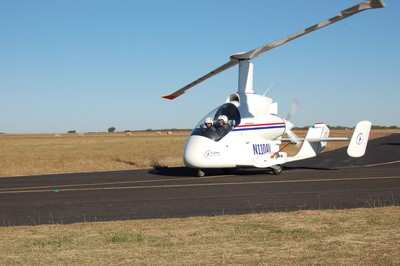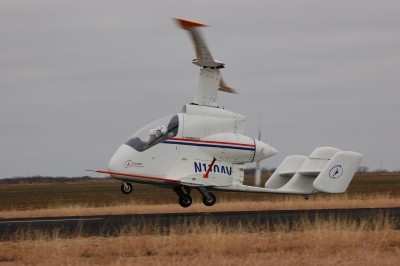Tue, Feb 01, 2011
Software Refinements Made For Improved Aircraft Control
Wichita Falls, TX-based Carter Aerospace Development said Monday
that they have completed the first phase of flight-testing of their
new Personal Air Vehicle (PAV). The PAV began flight-testing in
October 2010 with the goal of testing and refining the flight
control systems for the aircraft. Taxi tests were followed by short
hops down the runway and after each test refinements were made to
the aircraft controls. During each flight sensors on the aircraft
downloaded more than sixty (60) channels of information on the
aircraft's performance to the control room computer. Four cameras
also recorded the visual performance of the aircraft including the
pilots and controls in the cockpit. Almost all flight controls on
the PAV are automated and controlled by an on-board computer.
During testing the computer software was refined several times to
improve flight control and increase aircraft performance.

Carter PAV
The highlights of the Phase I flight-testing were the PAV's
first flight pattern on December 2, 2010, the first 30- minute +
flight on January 5, 2011 and the first jump take-off on January
18, 2011. According to Carter Aerospace President, Jay Carter, Jr.,
"We decided to breakdown the PAV flight-testing into two phases so
that it would be easier to validate the control functions of the
aircraft. For take-off and landing it's an autogyro. For cruise
it's a fixed-wing. We've now tested and refined the autogyro
segment proving that we have the capability to do jump take-offs
and zero-roll landings. This is a huge accomplishment for us. A
major advantage of our technology is its vertical take-off and
landing (VTOL) capability."

While the PAV only logged a few hours of flight time during
Phase I, it completed multiple take-offs and landings, including 8
jump take-offs. Much more extensive flight-testing will take place
during Phase II when Carter will add the 45-foot wing section to
the aircraft. With the wings added Carter will begin expanding the
flight envelope by transitioning the lift from the PAV's rotor to
the wing. With lift on the wings Carter can decrease the rotor rpm
and increase flight speed. This is the basis for Carter's patented,
Slowed Rotor/ Compound (SR/CTM) technology.
More News
Aero Linx: Aviators Code Initiative (ACI) Innovative tools advancing aviation safety and offering a vision of excellence for aviators. The ACI materials are for use by aviation pra>[...]
Make Sure You NEVER Miss A New Story From Aero-News Network Do you ever feel like you never see posts from a certain person or page on Facebook or Instagram? Here’s how you c>[...]
From 2016 (YouTube Edition): Who You Gonna Call When You Have a Rocket Engine that Needs a Spacecraft? While at EAA AirVenture 2016, ANN CEO and Editor-In-Chief, Jim Campbell, sat >[...]
"In my opinion, if this isn't an excessive fine, I don't know what is... The odds are good that we're gonna be seeking review in the United States Supreme Court. So we gotta muster>[...]
Expedite Used by ATC when prompt compliance is required to avoid the development of an imminent situation. Expedite climb/descent normally indicates to a pilot that the approximate>[...]
 ANN's Daily Aero-Linx (04.30.25)
ANN's Daily Aero-Linx (04.30.25) ANN FAQ: Turn On Post Notifications
ANN FAQ: Turn On Post Notifications Classic Aero-TV: Agile Aeros Jeff Greason--Disruptive Aerospace Innovations
Classic Aero-TV: Agile Aeros Jeff Greason--Disruptive Aerospace Innovations Aero-News: Quote of the Day (04.30.25)
Aero-News: Quote of the Day (04.30.25) ANN's Daily Aero-Term (04.30.25): Expedite
ANN's Daily Aero-Term (04.30.25): Expedite




